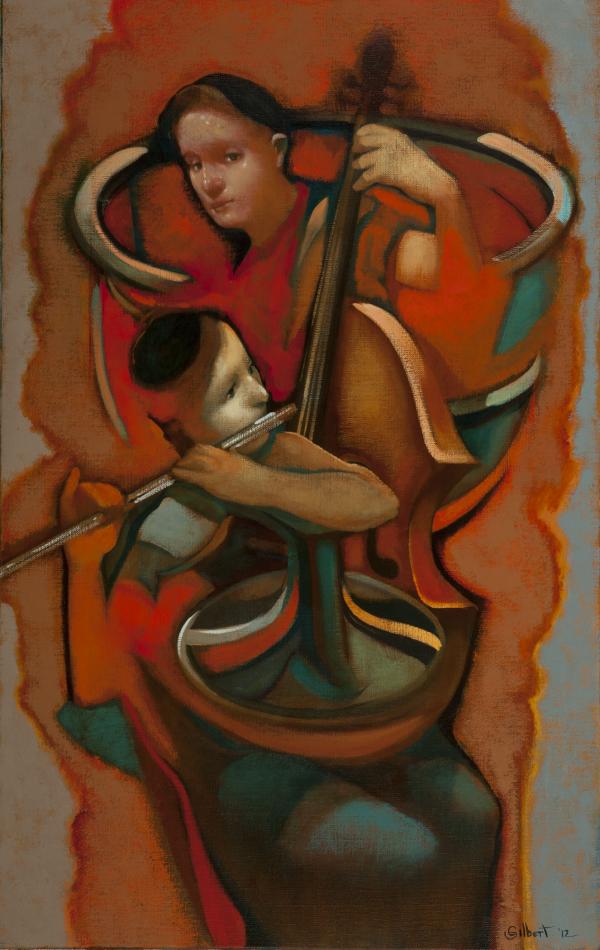Solo and Ensemble Music of Jewish Spirit
From the curator
These musicians really played as a group in a way I’d never experienced before. There was a different sense of time. Everyone was tuned in to each other; there was a give and take.
—Billy Childs (on his first time working with a chamber ensemble)
Chamber music is often considered the most profound medium of musical expression, a performance context that fosters intimate interaction and deep aesthetic experience. Intimate Voices presents a collection of chamber works spanning decades and illustrating a broad range of approaches to Jewish music.
The volume begins with two works by Joseph Achron, who belonged to the Society for Jewish Folk Music and helped advance its efforts to create a "national" Jewish music based on Jewish liturgical and folk traditions (see Joseph Achron's biography for more on the Society). These pieces illustrate Achron's frequent use of biblical cantillation motifs as thematic material in secular compositions. Neil W. Levin points to the appeal of this approach in his notes to Achron’s Children’s Suite:
As the perceived oldest layer of aggregate Judaic musical continuity, the constituent motifs (ta’amei hamikra) of the variant regional cantillation systems, traditions, and rites provided an inherently Jewish thematic framework and a means of rooting particular works in an authentic oral tradition
Levin’s program notes to the works in this volume offer insightful examinations of the various sources the composers employ. Aside from cantillation, those include liturgical contexts, folk traditions, and biblical episodes.
The string quartets by John Zorn and Jacob Weinberg are each based on the traditional Ashkenazi melody for the kol nidre. But where Zorn develops obscured fragments of the theme, Weinberg quotes the melody directly and combines it with other traditional tunes from the High Holy Day liturgy. Darius Milhaud’s Études utilizes melodies of minhag Carpentras, the centuries-old liturgical tradition of the Provençal region of France.
Two other works offer examples of composers who have drawn from the bible: Frederick Jacobi’s Hagiographa depicts scenes from the books Job, Ruth, and Prophets, while Ezra Laderman’s Partita for Solo Cello represents the composer’s highly personal responses to passages from the biblical Book of Isaiah.
Drawing on folk sources and inspiration are the two Schoenfield quartets, Tales from Chelm and Memoirs. (Each of these could easily serve as a master class on the Jewish string quartet.) Sholom Secunda is known primarily for his work in the Yiddish theater. But his string quartet, which employs prayer melodies, and cantorial and klezmer motifs, reveals the broad background he had in many realms of Jewish music.
Still, other works included here are Jewish in conception and spirit rather than specific musical or programmatic material. Shulamit Ran conceived of her contribution to this volume as a “wordless prayer,” with the horn standing in for the human voice and the ensemble of woodwinds and timpani acting as a choir. Meyer Kupferman’s The Shadows of Jerusalem is a haunting setting of one of the composer’s Holocaust-themed poems. The “Jerusalem” in the title, he explained in an oral history, is a reference to childhood memories of hearing the word “yerushalayim” but not understanding what it meant.
If pressed to find common ground among these works one might point to the composer Ernest Bloch, who adhered to a very inclusive definition of Jewish music. For Bloch, Jewish scales, folk sources, biblical events, and a perceived Jewish “feeling” were all equally legitimate foundations on which to base a Jewish work. Several Bloch works included here illustrate his broad approach.
So, if the works in Intimate Voices seems a disparate lot it is because the American Jewish experience has itself been multivalent, and because the freedom and depth afforded by the medium of chamber music deftly accommodates this. Perhaps this also points to an issue with the Society for Jewish Folk Music’s vision that a single, unified national Jewish music could emerge from such a diverse and divergent people.















